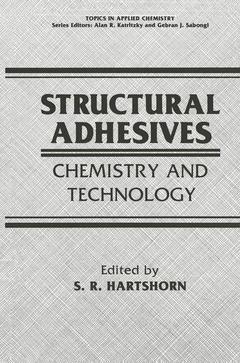Description
Structural Adhesives, Softcover reprint of the original 1st ed. 1986
Chemistry and Technology
Topics in Applied Chemistry Series
Coordinator: Hartshorn S.R.
Language: English
Subjects for Structural Adhesives:
Publication date: 11-2012
524 p. · 15.2x22.9 cm · Paperback
524 p. · 15.2x22.9 cm · Paperback
Description
/li>Contents
/li>
Adhesives in general and structural adhesives in particular are the subjects of much academic interest as well as commercial importance. Structural bonding, as a method of joining, offers a number of advantages over mechanical fastening. However, in order to achieve satisfactory results, the proper adhesive must be selected and the appropriate bonding procedures followed. The purpose of Structural Adhesives: Chemistry and Technology is to review the major classes of structural adhesives and the principles of adhesion and bonding as these relate to structural joints. Each chapter provides an overview of the topic under discussion with a list of references to the relevant literature. In addition to describing the chemistry involved, other aspects of structural adhesive technology are covered, such as formula tion, testing, and end uses. Some structural adhesives, especially epoxies and phenolics, have a long history of successful use and are now widely employed. Others, such as the structural acrylics and cyanoacrylates, are beginning to gain industrial acceptance. Urethanes and anaerobics have limited but important uses, while high-temperature adhesives are still largely in the research and development stage.
I. Definitions.- II. Background.- III. Markets for Structural Adhesives.- IV. Applications.- References.- 1. Fundamentals of Structural Adhesive Bonding.- I. Introduction.- II. Physical Properties of Polymers and Adhesives.- III. Surface Energy and Aspects of Cohesion.- IV. Theories of Adhesion.- V. Criteria for Optimum Bond Strength.- References.- 2. Phenolic Resins.- I. Introduction.- II. Mechanism of Phenol-Formaldehyde Reactions.- III. Curing Reactions.- IV. Structural Phenolic Adhesives.- References.- 3. Epoxy Structural Adhesives.- I. Introduction.- II. Compounding Epoxy Structural Adhesives.- III. Recent Developments in Epoxy Structural Adhesives.- References.- 4. Polyurethane Structural Adhesives.- I. Introduction.- II. Polyurethane Chemistry.- III. Structure-Property Relationships in Polyurethanes.- IV. Polyurethane Structural Adhesive Applications.- References.- 5. Anaerobic and Structural Acrylic Adhesives.- I. Introduction.- II. Anaerobic Adhesives.- III. Structural Acrylic Adhesives.- References.- 6. Cyanoacrylate Adhesives.- I. Introduction.- II. Cyanoacrylate Chemistry.- III. Cyanoacrylate Adhesive Properties.- IV. Cyanoacrylate Application and Uses.- V. Summary.- References.- 7. High-Temperature Polymers and Adhesives.- I. Introduction.- II. High-Temperature Polymers.- III. High-Temperature Adhesives.- IV. Bonding Technology of High-Temperature Adhesives.- V. Applications of High-Temperature Adhesives.- VI. Trends and Conclusions.- References.- 8. The Durability of Structural Adhesive Joints.- I. Introduction.- II. Factors Affecting Durability.- III. The Effect of Water.- IV. Assessment of Durability.- V. Summary.- References.- 9. Testing, Analysis, and Design of Structural Adhesive Joints.- I. Introduction.- II. Mechanical Testing of Adhesive Joints.- III. Stress Analysis of Adhesive Joints.- IV. Fracture Mechanics of Adhesive Joints.- V. Adhesive Joint Design.- VI. Summary.- References.- 10. Industrial Application Methods.- I. Introduction.- II. Factors Affecting the Choice of a Method of Application.- III. Application Methods and Equipment.- IV. Conclusion.- Appendix I: Standard Definitions of Terms Relating to Adhesives.- Appendix II: SI Units and Conversion Factors.- Appendix III: ASTM Standards Relating to Adhesives.
© 2024 LAVOISIER S.A.S.

